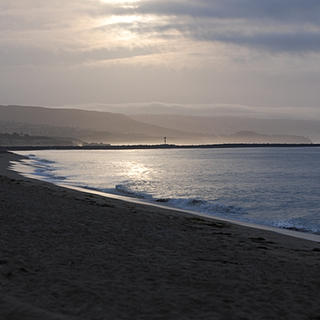Restorative Mornings: Observations from a Restoration Intern
- OC Habitats
- Mar 22, 2021
- 3 min read
As the early morning light gently illuminates the inlets and rolling hills of the Newport Back Bay, fog caresses the land and lingers along the shore; it is as though it wishes to stop the warmth of the sun from driving it away. Yet the sun still rises and wipes the slate clean for all the beings beginning to stir. A gentle breeze creates calming music with the tree branches and cattails (Typha) and high overhead a ravenous raptor——the handsome Osprey——studies the landscape.

The sun raises ever higher and the sounds of high-pitched chirping, water splashing, insect buzzing, and bicycle gears shifting energize the landscape. The hummingbirds (Trochilidae) begin their lively, morning conversation. They chirp over each other like little New Yorkers, and chase each other in a never-ending game of tag. The great blue heron ignores her loud neighbors as she stands solemn and solitary. In a flash she lunges her beak into the water and returns to the surface with a silver mullet prize. Honey bees (Apis) play witness to the heron’s morning fishing as they eagerly search for pollen. As the honeybees quiet their buzz to land on the buckwheat (Eriogonum fasciculatum) blooms, their silent pollinator friends, the butterflies (Rhopalocera), enjoy the fuzzy, floral, delights of the mulefat. Along the paved shoreline, cyclists, joggers, and power walkers, seemingly oblivious to the lively ecosystem, get their morning exercise. Water, the sentinel of all this life, flows steadily and rhythmically caring not for the flurry of activity around it. Standing witness to all the events of the day are the OCH restoration interns and volunteers.

Saturday mornings in the Back Bay have come to be a sanctuary for those kept at home due to quarantine. The thriving riparian realm offers the chance for human redemption. Though a great deal of land development damage has been done to riparian and wetland habitats, Upper Newport Bay offers us a chance to restore and protect essential environments. Without the restoration work, we would witness a tragic trophic cascade. This is why we in the cyan shirts——wielding loppers, plants, and mulch——commit to the restoration work.
All riparian species, whether primary producers, secondary consumers, or tertiary consumers, rely on the health of one another. The silver mullet (Mugil curema) relies on clean water, sea lettuce (Ulva), and insects in order to reproduce and joyously jump through the air in a celebration of life. If the ever important water is prevented from flowing (either by plastic waste or invasive herbaceous species) the mullet will immigrate to friendlier shores. Soon after, the Great Blue Heron (Ardea herodias) and the Osprey (Pandion haliaetus) would abandon the once fertile hunting ground. Meanwhile, non-native invasive species like the Algerian Sea Lavender (Limonium ramosissimum) and the flammable Black Mustard (Brassica nigra) would silently sail into port like pillaging pirates and commandeer all the land from the native species; spreading like a poison through the veins of the landscape. The important spiny rush (Juncus acutus), the mulefat (Baccharis salicifolia), and the arroyo willow (Salix lasiolepis) would lose real estate, resources, and nutrients until finally perishing at the roots of their invasive brethren. Important sources of nectar would be lost to the pollinators, and important breeding grounds for insects and birds would be diminished leading to the demise of innocent species. The thought of this loss is motivating. Though our muscles burn with each heave of heavy mulch or chop with the loppers through an invasive tree, we persevere. We are rewarded with planting native species in the habitat we worked hard to clear, and the sights of a thriving ecosystem we relished restoring.

As the sun rises higher and hotter above us, we are signaled that our work for the day is done. We collect our gear and make our way back through the coastal scrub. The Osprey, perched high above us, observes our progress silently. The Great Blue Heron stands witness in the flowing water nearby. Honey bees and butterflies fly in for a taste of the newly planted nectar. Hummingbirds talk to us as we make our way across the trail. The earthy scent of native shrubs and trees fill our nostrils as we descend toward civilization. We make our way back to the pavement and we are greeted by cyclists wishing us a good morning. Finally, we arrive at our Back Bay base—the Back Bay Science Center—to return our tools. As we walk toward our vehicles, willets (Tringa semipalmata) fly overhead and Canadian Geese (Branta canadensis) honk farewells. To our homes we return until next Saturday when we greet our riparian refuge again.







Comments